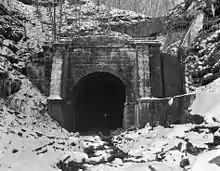Board Tree Tunnel
The Board Tree Tunnel, near Littleton, West Virginia, was built between 1851 and 1858 by the Baltimore and Ohio Railroad on its main line between Baltimore, Maryland, and Wheeling, West Virginia, under the supervision of B&O chief engineer Benjamin Henry Latrobe, II. The 2,350-foot (720 m)[1] tunnel used a segmental cast iron lining system pioneered on the contemporaneous Kingwood Tunnel on the same line.[2]
 South portal of Board Tree Tunnel in 1974 | |
| Overview | |
|---|---|
| Location | Littleton, West Virginia |
| Coordinates | 39.72191°N 80.53021°W |
| Status | abandoned |
| Operation | |
| Work begun | 1851 |
| Constructed | brick and cut stone |
| Opened | 1858 |
| Technical | |
| Length | 2,350 feet (720 m) |
| Track gauge | 4 ft 8 1⁄2 in (1,435 mm) |
Workers were recruited from coal mines in the area to excavate the tunnel. The tunneling operations used black powder as explosive. About 30 deaths and 300 injuries occurred in the excavation of the Board Tree and Kingwood tunnels. The tunnel is now abandoned.[2]
References
- Zembala, Dennis (1984). "Baltimore & Ohio Railroad, Kingwood Tunnel, Tunnelton vicinity, Preston, WV" (PDF). Historic American Engineering Record. Retrieved 6 August 2013.
- Clement, Dan (1984). "Board Tree Tunnel, Littleton vicinity, Marshall, WV". Historic American Engineering Record. Retrieved 6 August 2013.
External links
- Historic American Engineering Record (HAER) No. WV-37, "Board Tree Tunnel, Littleton, Wetzel County, WV", 11 photos, 2 data pages, 1 photo caption page
This article is issued from Wikipedia. The text is licensed under Creative Commons - Attribution - Sharealike. Additional terms may apply for the media files.